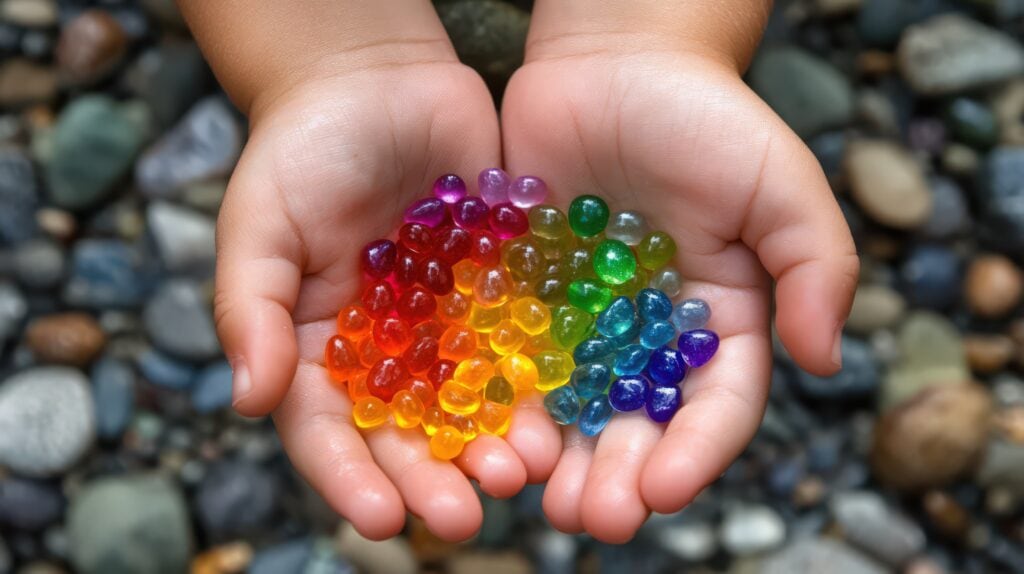What Are Water Beads?
“Water beads” are water-absorbent polymer beads that can swell over several hundreds of times their initial dry mass when placed in water, forming hydrogel beads. They are primarily marketed as agricultural products to act as humectants in soil, helping retain and slowly release water into the soil.
Beyond farming, however, water beads have been marketed as colorful sensory toys for play and decoration. This non-agricultural use has raised safety concerns, especially when the beads are accessible to young children who may accidentally ingest them.
What Are the Hazards of Water Beads?
A 2025 case study, published in Pediatrics, documented a 13 month-old who was admitted to the emergency room after a 12 hour stint of vomiting and lethargy[1]. She presented as dehydrated, abdominal distension and tenderness. A radiograph and ultrasound showed a mass in the small intestine, which a laparotomy confirmed to be swollen fragments of water bead material.
The mass was removed, which resulted in partial recovery. The patient continued to show developmental symptoms, and 9 months after the initial mass was removed, a colonoscopy revealed inflammation of the ascending and sigmoid colons and additional gelatinous fragments consistent with water bead material. The patient’s motor skills and speech skills required early childhood intervention. This case underscores the risk of intestinal obstruction and possible neurotoxic effects associated with water bead ingestion.
What Are Water Beads Made Of?
The study author noted that some manufacturers claim the sensory toy water beads are made exclusively of sodium polyacrylate, which is the salt form of polyacrylic acid, a common hydrogel often used as the sorbent in diapers. However, characterization testing performed by Cambridge Polymer Group scientists showed that commercially-available water beads procured by the author and sold as sensory toys, found they were predominantly comprised of polyacrylamide, which is synthesized from acrylamide monomer. Polyacrylamide has a different toxicological risk profile than polyacrylate and hence needed additional scrutiny for its use as a toy.
What Is the Current Regulation on Water Beads?
The lead author of the 2025 study collaborated with the Consumer Product Safety Commission (CPSC) to highlight the risks posed by these products. The CPSC’s own testing of 14 water bead toy products revealed:
- Detectable residual acrylamide monomers in most products
- Two products exceeding acute oral minimum risk levels
- Significant batch-to-batch variability in monomer content
To protect consumers, the CPSC launched public guidance warning parents not to allow children to play with water beads[2]. On August 21, 2025, the Commission approved a new federal safety standard regulating water bead toys. The standard imposes two major restrictions:
- Limits on permissible concentrations of polyacrylamide
- Rules on maximum allowable bead size when fully swollen to reduce choking and intestinal obstruction risks[3]
What Is Next?
Water beads may have benefits in farming, but as toys, they present serious risks. With new safety standards in place and ongoing research, regulatory science is catching up to protect the most vulnerable consumers.
At Cambridge Polymer Group, we continue to work with companies to characterize the chemical composition of hydrogel materials in consumer products. Our goal is to help ensure these materials are safe, compliant, and effective—whether in agricultural settings or other approved applications.
If your company is working with hydrogels—whether for consumer products, agriculture, industrial, or medical applications—Cambridge Polymer Group can help. From material characterization and performance testing to product development and risk assessment, our scientists provide the insights you need to innovate with confidence. Connect with us to see how we can support your next project.
[1] Haugen A, Friedman E, and Duff I. Intestinal Obstruction and Neurotoxicity Associated With Water Bead Ingestion. Pediatrics. 2025;155(2): e2023065575
[2] https://www.cpsc.gov/Safety-Education/Safety-Education-Centers/Water-Beads-Information-Center
[3] https://www.cpsc.gov/Newsroom/News-Releases/2025/CPSC-Approves-New-Federal-Safety-Standard-for-Water-Beads-to-Reduce-the-Risk-of-Injury-and-Death-to-Young-Children

